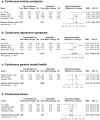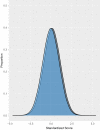Systematic review of mental health symptom changes by sex or gender in early-COVID-19 compared to pre-pandemic
- PMID: 35794116
- PMCID: PMC9258011
- DOI: 10.1038/s41598-022-14746-1
Systematic review of mental health symptom changes by sex or gender in early-COVID-19 compared to pre-pandemic
Abstract
Women and gender-diverse individuals have faced disproportionate socioeconomic burden during COVID-19. There have been reports of greater negative mental health changes compared to men based on cross-sectional research that has not accounted for pre-COVID-19 differences. We compared mental health changes from pre-COVID-19 to during COVID-19 by sex or gender. MEDLINE (Ovid), PsycINFO (Ovid), CINAHL (EBSCO), EMBASE (Ovid), Web of Science Core Collection: Citation Indexes, China National Knowledge Infrastructure, Wanfang, medRxiv (preprints), and Open Science Framework Preprints (preprint server aggregator) were searched to August 30, 2021. Eligible studies included mental health symptom change data by sex or gender. 12 studies (10 unique cohorts) were included, all of which reported dichotomized sex or gender data. 9 cohorts reported results from March to June 2020, and 2 of these also reported on September or November to December 2020. One cohort included data pre-November 2020 data but did not provide dates. Continuous symptom change differences were not statistically significant for depression (standardized mean difference [SMD] = 0.12, 95% CI -0.09-0.33; 4 studies, 4,475 participants; I2 = 69.0%) and stress (SMD = - 0.10, 95% CI -0.21-0.01; 4 studies, 1,533 participants; I2 = 0.0%), but anxiety (SMD = 0.15, 95% CI 0.07-0.22; 4 studies, 4,344 participants; I2 = 3.0%) and general mental health (SMD = 0.15, 95% CI 0.12-0.18; 3 studies, 15,692 participants; I2 = 0.0%) worsened more among females/women than males/men. There were no significant differences in changes in proportions above cut-offs: anxiety (difference = - 0.05, 95% CI - 0.20-0.11; 1 study, 217 participants), depression (difference = 0.12, 95% CI -0.03-0.28; 1 study, 217 participants), general mental health (difference = - 0.03, 95% CI - 0.09-0.04; 3 studies, 18,985 participants; I2 = 94.0%), stress (difference = 0.04, 95% CI - 0.10-0.17; 1 study, 217 participants). Mental health outcomes did not differ or were worse by small amounts among women than men during early COVID-19.
© 2022. The Author(s).
Conflict of interest statement
The authors declare no competing interests.
Figures



References
-
- World Health Organization. WHO Coronavirus Disease (COVID-19) Dashboard. https://covid19.who.int/. Accessed June 3, 2022.
-
- World Health Organization. Impact of COVID-19 on people’s livelihoods, their health and our food systems: joint statement by ILO, FAO, IFAD and WHO. https://www.who.int/news/item/13-10-2020-impact-of-covid-19-on-people%27... (2020). Accessed June 3, 2022.
-
- Aknin, L, et al. The Pandemic Did Not Affect Mental Health the Way You Think. The Atlantic.https://www.theatlantic.com/ideas/archive/2021/07/covid-19-did-not-affec... (2021). Accessed June 3, 2022.
-
- Sun, Y. et al. Comparison of mental health symptoms prior to and during COVID-19: evidence from a living systematic review and meta-analysis. Preprint at 10.1101/2021.05.10.21256920 (2021). Accessed June 3, 2022.
Publication types
MeSH terms
Grants and funding
LinkOut - more resources
Full Text Sources
Medical

